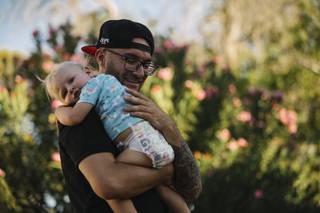Angelo Calabrese injured his back when he was 18 and heading to college on a football scholarship.
He was prescribed pain pills for the injury. The comfort and relief from the medication was addicting.
“When I got introduced to opiates, it was like a warm blanket,” he said.
Calabrese said he borrowed and stole money to fuel the addiction, doing anything to get OxyContin, Vicodin, heroin and fentanyl — a powerful synthetic opioid 50 to 100 times more potent than morphine.
Related content
Fentanyl deaths are on the rise. With the year about halfway through, 63 people in Clark County have died of fentanyl, or one less death than in all of 2019. In 2018, there were just 46 deaths.
In 2019, an estimated 69,029 people died of a drug overdose in the United States. Roughly 7 out of 10 of these overdose deaths were due to opioids. Nearly half of all overdose deaths, or 47%, were due to fentanyl or other synthetic opioids besides methadone, according to Centers for Disease Control statistics.
Calabrese, who has twice overdosed, knows he’s fortunate to be alive.
“The mentality on the streets is, if you know someone who overdosed on heroin, ‘I want to go and try to find that heroin because that’s the good (stuff).’ The way that your mind works when you’re in the grips is pretty insane,” he said.
Fentanyl is absorbed through the skin as a patch but can also come in powder form. Powder fentanyl is often mixed into other substances, such as heroin.
Southern Nevada Health District senior epidemiologist Kathryn Barker said illegally made fentanyl mixed with other drugs is the cause of many overdoses.
“They may think they’re taking an Oxycodone or Xanax that they bought on the street, but it actually had fentanyl in it,” Barker said. “We want people to know that even if they’re not seeking out fentanyl, it could be in drugs that they’re using.”
There has been an increase in clients at the Center for Behavioral Health who have tested positive for opioids unknowingly, said Krista Hales, director of the group’s Integrated Opioid Treatment Recovery Center. Those users have admitted to taking drugs such as meth, which suggests they were laced with fentanyl.
“We’re not seeing pure substance use anymore. We’re even seeing things like marijuana and cocaine and methamphetamine laced with fentanyl,” Hales said.
Christina Madison, associate professor of pharmacy at Roseman University of Health Sciences, said fentanyl overdoses are likely caused by laced drugs and not those prescribed legally. Changes to state guidelines for writing prescriptions for controlled substances require physicians to provide patient education on the addictive nature of opioids before writing a prescription, she said.
The Center for Behavioral Health has expanded medication-assisted treatments in response to increased use of fentanyl in clients. The recovery center provides all three FDA-approved medication-assisted treatments — methadone, buprenorphine and vivitrol — in oral, injectable and implanted forms.
The goal is for addicts to stabilize without medication, but not everyone can stop immediately instead of gradually tapering off, Hales said. Many clients with addictions have jobs and are the primary financial supporters of their families.
“We understand that realistically not everyone can cut cold turkey,” she said.
Calabrese said he’s been sober for five years and now has a 3-year-old son. “To be able to get out of my own way and let God steer the ship is pretty powerful,” he said.
If you need help with addition, call the Substance Abuse and Mental Health Services Administration’s national hotline at 1-800-662-HELP (4357). The Health District offers free naloxone at its pharmacy located at 280 S. Decatur Blvd.


